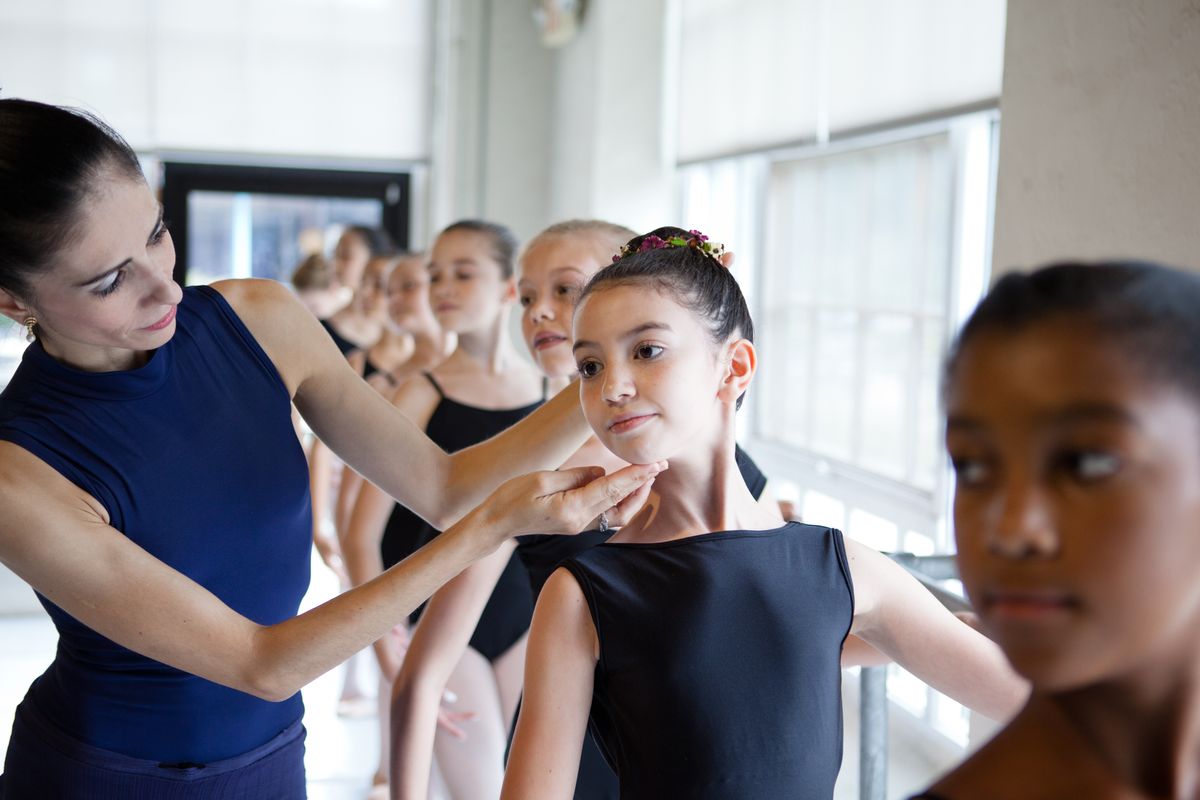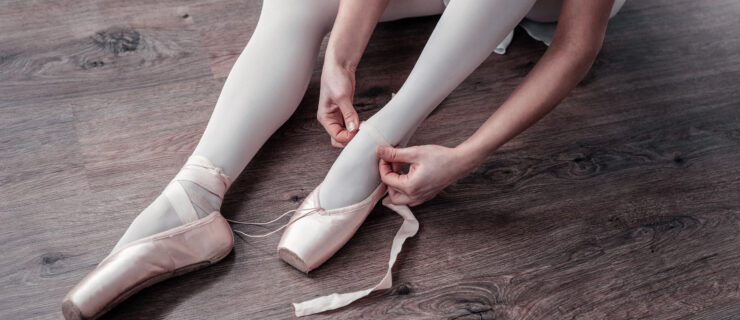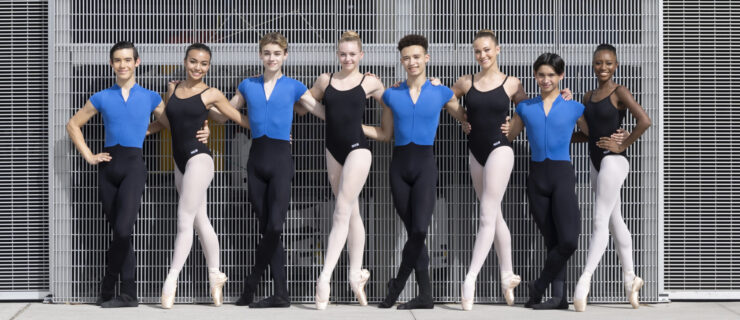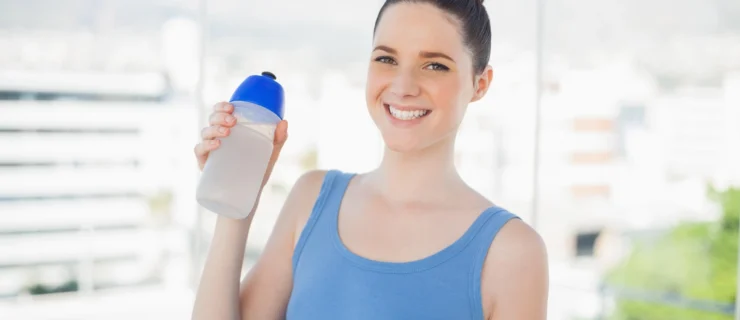Reinvigorate Your Technique with These 4 Fresh Corrections
Updated 10/17/22.
This story originally appeared in the April/May 2015 issue of Pointe.
Growing up, Houston Ballet first soloist Allison Miller often heard teachers compare the feeling you have during pirouettes to a corkscrew. But then her teacher, Diane Partington in Ellenton, Florida, offered up a surprising new analogy. Partington suggested Miller imagine a bank tube—a simple cylinder that uses suction to transport a round canister from a customer’s car to the teller. Picturing this straight, narrow tube drawing energy up and into itself struck a chord with Miller. “It worked instantly!” she says. “It clicked in my head and it gave my body the right feeling.” Even now, if she needs to refocus her pirouettes, Miller thinks of that image. “If I’m having a bad day, it helps me find my center.”
Miller is not alone in experiencing this kind of breakthrough moment. Common (and commonly phrased) corrections can grow stale for all dancers, regardless of age or skill level. The words become so familiar that they don’t register in your brain or your body. But things change when you’re given a new way to envision these adjustments. Your development as a dancer, says University of North Carolina School of the Arts dean of dance Susan Jaffe, “is in these ‘aha’ moments, layers and layers of real, deep, empirical understanding of things.”
To help you build your own repertoire of creative imagery, Pointe spoke with several teachers, including Jaffe. Together, they provide a wellspring of new ways to think about humdrum corrections.
“Don’t Tuck Under”
 Houston Ballet soloist Allison Miller in rehearsal. Photo by Amitava Sarkar, Courtesy HB.
Houston Ballet soloist Allison Miller in rehearsal. Photo by Amitava Sarkar, Courtesy HB.
Fresh Take:
Imagine a “skeleton hanging from a string,” says Jaffe. Why? Because when teachers say, “don’t tuck,” they’re really asking you to reestablish your vertical alignment. “You need to maintain the natural curvature of the spine,” says Jaffe.
The Real Issue:
Dancers often tuck, or scoop, their pelvis when they’re trying to access their turnout. This throws off alignment and creates a host of other problems. “If you tuck under, you cannot get to those lower muscles under the pelvis,” says Jaffe. “It’s a fake feeling of turnout, and you can’t actually straighten your knee when you’re tucked.”
To achieve proper turnout, Jaffe says, you must engage your pelvic area and your core. “It’s like you’re sucking your muscles in to the center of your body,” she says. “Those muscles are hugging your bones and you’re pulling them in.”
Peter Stark, the dance department chair of the Patel Conservatory in Tampa, Florida, offers a similar image. “The upper thigh is wrapping around the back of the leg as opposed to squeezing the butt,” he says.
“Don’t Drop Your Elbows”
 Peter Stark correcting students. Photo by Michelle Revels, Courtesy Patel Conservatory.
Peter Stark correcting students. Photo by Michelle Revels, Courtesy Patel Conservatory.
Fresh Take:
“With the arms in first, pretend your arms are a hula hoop,” says Stark. Then imagine you’ve stepped inside the hula hoop. The line created by your arms extends all the way around your body to your back. “It’s all connected. It’s not just elbow or shoulder or hand.”
If that doesn’t click, try this image from Arantxa Ochoa, director of faculty and curriculum at Miami City Ballet School: “If you put a drop of water on the shoulder, it has to go down to the fingers. And if your elbow is dropped, the water gets caught.”
The Real Issue:
This correction is another way of asking you to support your arms, which is of particular importance for pirouettes. “Lifting your elbows means engage your arms, engage your back,” says Jaffe. “It’s this invisible energy between your back and your elbows that holds you up. It feels like helium.”
But supported arms will look different on each dancer. “There’s a line that goes from the nape of the neck to the shoulder,” says Stark. “Some people have a sloping line; for others, it’s more straight-shouldered. That line has to continue in second position to your pointer finger. It’s not a matter of high or low. You’re trying to match the line that exists in your body.”
“Square Off Your Arabesque”
 Susan Jaffe teaching at UNCSA. Photo by Peter Mueller, Courtesy UNCSA.
Susan Jaffe teaching at UNCSA. Photo by Peter Mueller, Courtesy UNCSA.
Fresh Take:
Jaffe says to think of a twisting energy in your rib cage to counteract your open hip, “like an internal ‘S.’ ” For example, if your left leg is in arabesque, you “square off” by feeling an opposite, twisting energy pulling up through the left side of your ribs. “Otherwise you’ll collapse the rib cage on the lifted hip,” Jaffe explains. “You need to lift out of that.”
The Real Issue:
“Square off” can be misleading when it comes to arabesque or attitude. “If you’re lifting your leg in arabesque, your hip bones cannot be square because your knee and the top of your arch will face the floor,” says Jaffe. “They have to face the audience, and in order for that to happen, you have to lift your hip. What is square is the rib cage.”
“Don’t Wind Up”
 Ochoa in class. Photo by Alexander Iziliaev, Courtesy PAB.
Ochoa in class. Photo by Alexander Iziliaev, Courtesy PAB.
Fresh Take:
When preparing for pirouettes from fourth position,”use the back foot like a hand, like a chimpanzee,” says Stark. “You’re grabbing the floor with your foot.” This focuses your attention on the real source of your turning energy—your foot pushing off the floor. Ochoa offers a similar, but more abstract, suggestion. “Think with your toes,” she says. “Your brain is there.”
The Real Issue:
Dancers aiming for powerful pirouettes may mistakenly rely on their arms and torso to create momentum. This upsets the alignment of your hips and shoulders, and thus your balance. “The motivation of the turn really needs to come from the bottom,” says Stark.
Sometimes it takes unexpected ideas to release your potential, because you never know what phrase or image will do the trick. “When I think about the ‘aha moments,’ it could’ve been one word,” says Jaffe. “I hear that one word and suddenly it changes my life. That’s what you need to be open to.”





